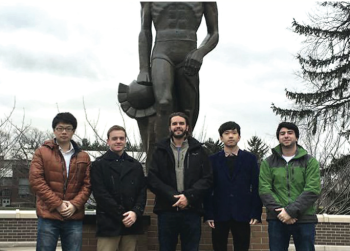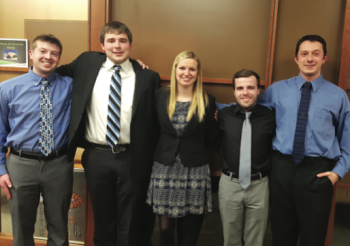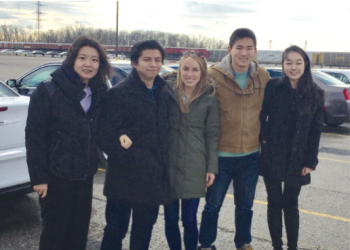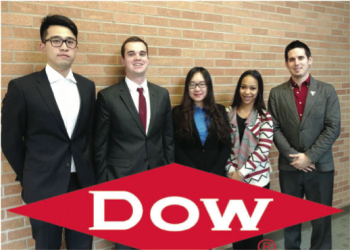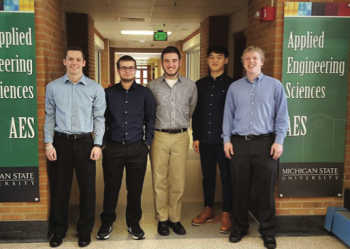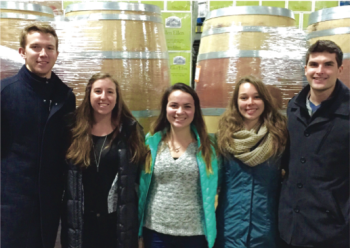Applied Engineering
Projects
We gratefully acknowledge Jim Manely and the Demmer Center for Business Transformation at Michigan State University for their guidance and assistance with our projects. We gratefully acknowledge Judy S. Jacobs, Director, Corporate & Student Relations Office, Michigan State University, Department of Supply Chain Management for her assistance in securing projects.
For information on becoming a project sponsor, please contact Dr. Laura Genik.
Applied Engineering students participate in Spring Term Design Day. The following were the project sponsors and projects for the Spring of 2016:
AbbVie: Operations Brand Team – Creating the “Perfect Brand”
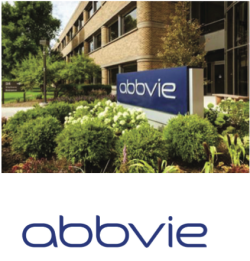 AbbVie is a research focused biopharmaceutical company headquartered in North Chicago, Illinois with global operations. AbbVie is considered a patient-first company that will go out of their way to ensure customer satisfaction. There are many supply chains that are required for end-to-end product development and delivery. AbbVie increases value in their supply chains by implementing Brand Teams. Currently, AbbVie has 14 Brand Teams that operate under the company’s direction. Our goal was to simplify the interaction between Brand Teams in order to have a cross-functional supply chain.
AbbVie is a research focused biopharmaceutical company headquartered in North Chicago, Illinois with global operations. AbbVie is considered a patient-first company that will go out of their way to ensure customer satisfaction. There are many supply chains that are required for end-to-end product development and delivery. AbbVie increases value in their supply chains by implementing Brand Teams. Currently, AbbVie has 14 Brand Teams that operate under the company’s direction. Our goal was to simplify the interaction between Brand Teams in order to have a cross-functional supply chain.
After two conference calls with AbbVie, we were given the task of evaluating their Brand Team. This entailed completing a SWOT analysis of a few specific brand teams, followed by comparing our SWOT to the analysis done by the manager of all the Brand Teams. Furthermore, we developed a method for AbbVie to rate the performance of each of their Brand Teams, for example a scorecard, to see if they are progressing and are worth continuing in the future. Currently, AbbVie has no uniform standards for all of the Brand Teams nor a way to judge their effectiveness and performance. It was necessary to create a process and scorecard to check Brand Team performance and determine standards that will be used for all Brand Teams.
AbbVie: Process Review for Safety Stock & Order Quantities Analysis
Recently spun off from Abbott, AbbVie is a world leader in the research and development, and production of pharmaceutical drugs. As of 2014, with revenue over $20B, they are 11th largest pharmaceutical company in the world. This project has two main focuses: MOQ and Safety Stock.
 MOQ (minimum order quantity) is the minimum amount of product the supplier/distributor determines economically viable to sell. AbbVie would like us to review their current MOQ process and find ways to improve it. There are many factors to consider when dealing with MOQ in the pharmaceutical industry that will need to be addressed in our recommendation.
MOQ (minimum order quantity) is the minimum amount of product the supplier/distributor determines economically viable to sell. AbbVie would like us to review their current MOQ process and find ways to improve it. There are many factors to consider when dealing with MOQ in the pharmaceutical industry that will need to be addressed in our recommendation.
The second part of the project is Safety Stock. Safety Stock is the reserve inventory to reduce stock outs. AbbVie wanted the team to look over their current safety stock process and recommend how to improve it. The team also reviewed and updated their safety stock numbers based on the recommendations. AbbVie currently has a large sum of assets in safety stock, which the team sees as an opportunity to save them money. The pharmaceutical industry poses unique challenges when dealing with safety stock that must be addressed, such as extreme demand uncertainty, risks in stock outs, government regulations, and short product lifecycles.
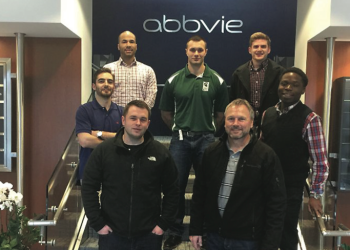
Team Members (L-R): Johnathon Tehlirian, Wallace Smith, Vincent Gessler, Garrett Derian-Toth, Oseloka Udegbunam
Cisco: ESD Packaging End-of-life Options
For more than 30 years Cisco Systems, Inc. has changed the way the world works, lives, plays, and learns through the development of networking technologies. Cisco designs a broad range of routing, switching, and other networking-based technologies. The technology and services are then delivered to customers as integrated solutions including cloud, video, mobility, security, collaboration, and analytics.
 Cisco employees are constantly challenged and empowered to “connect everything, innovate everywhere, and benefit everyone.” The CEO of Cisco Systems, Chuck Robbins, once said that “what is good for the world and good for business are more closely connected than ever before.” Mr. Robbins recognizes that in order to benefit everyone on a global scale, everyone must constantly maintain and improve the environment in which they live.
Cisco employees are constantly challenged and empowered to “connect everything, innovate everywhere, and benefit everyone.” The CEO of Cisco Systems, Chuck Robbins, once said that “what is good for the world and good for business are more closely connected than ever before.” Mr. Robbins recognizes that in order to benefit everyone on a global scale, everyone must constantly maintain and improve the environment in which they live.
Cisco’s Supply Chain Greenhouse Emission Reduction Program strives to eliminate the waste and costs associated with packaging, while also improving the customer experience. The “Pack It Green Initiative” focuses on optimizing packaging and order fulfillment and has recently taken an interest in Electrostatic Discharge (ESD) bags/packaging.
To date, end-of-life management of ESD bags has generally been limited to landfill disposal. The goal of this project is to investigate non-disposal options, such as recycling and repurposing, for the end-of-life management of ESD packaging.
The solution(s) to finding a method to repurpose or recycle ESD bags will be of benefit to not only Cisco but to the entire electronics industry. Diverting waste from landfill at multiple points along the product manufacturing life cycle will have an extremely positive impact on the environment.
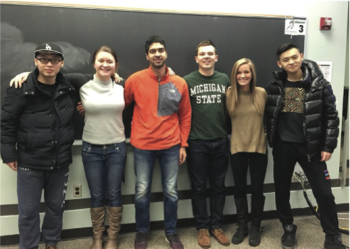
Team Members (L-R): Tony Li, Kora Nixon, Ahmed Mohammed, Michael Huebner, Danielle Helgerson, Yifan Zhang
Cisco: Digital Rights Management Solutions
Cisco, a worldwide leader in IT, helps companies seize the opportunities of tomorrow by proving that amazing things can happen when you connect the previously unconnected. Headquartered in San Jose, California, Cisco designs, manufactures, and sells networking equipment. With over 70,000 employees, Cisco aims to shape the future of the Internet by creating unprecedented value and opportunity for customers, investors, and ecosystem partners.
 Imagine a world where households can purchase digital content, such as blueprints for a product design from a digital distribution center, and print it off on their own 3D printer for manufacturing. How is the design protected? How are designers compensated? How are owners’ rights protected? These are some of the questions Cisco’s Digital Rights Management (DRM) team and the MSU team are trying to answer.
Imagine a world where households can purchase digital content, such as blueprints for a product design from a digital distribution center, and print it off on their own 3D printer for manufacturing. How is the design protected? How are designers compensated? How are owners’ rights protected? These are some of the questions Cisco’s Digital Rights Management (DRM) team and the MSU team are trying to answer.
The team is to explore Cisco’s Digital Rights Management, and find a solution that supports Cisco’s next-generation supply chain models. The digital rights management solution, when applied to a supply chain model, will manage both the rights to use and the compliance of use for the intellectual property, while protecting Cisco’s competitive advantage, revenue, and brand management.
The MSU team is to determine the form of the DRM entity. Is it physical or virtual? Is it distributed or centralized? In addition, the MSU team is to find a way to monitor and manage the DRM, as well as how to notify when legality is compromised. The project’s end goal is to protect digital rights and intellectual property throughout the entire supply chain stream.
Cisco: Analysis of Cisco’s Integrated Business Planning
Cisco is a global company with nearly 72,000 employees worldwide. One of the leading manufacturers of network equipment, Cisco’s primary business is in internet working products, such as routers, bridges, and switches. Our project will focus on performing a current state analysis and giving future state recommendations to help Cisco advance the maturity of their Integrated Business Planning services.
 IBP is an overarching decision-making process that aligns all business functions to support the company’s primary strategy. IBP is an extension of traditional Sales & Operations Planning, which typically relies on market supply and demand data. This information is extended to the rest of the corporation with IBP, forming a comprehensive business plan to drive higher customer satisfaction and profitability.
IBP is an overarching decision-making process that aligns all business functions to support the company’s primary strategy. IBP is an extension of traditional Sales & Operations Planning, which typically relies on market supply and demand data. This information is extended to the rest of the corporation with IBP, forming a comprehensive business plan to drive higher customer satisfaction and profitability.
The first phase of the project is to assess the current maturity state of IBP services in all market segments of Cisco. In order to do this, we will utilize internal customer-focused questionnaires and conduct virtual interviews with Cisco stakeholders. This information will then be used to complete a SWOT analysis of IBP services. This analysis will help us discover the current maturity and plan future state recommendations for IBP services within Cisco. Lastly, this will pave the way for an actionable roadmap for Cisco to advance IBP’s maturity in the next 12 months, and determine how IBP maturity can be incorporated into existing services.
Fiat Chrysler Automobiles: FCA Assembly Planet Vehicle Releasing Study
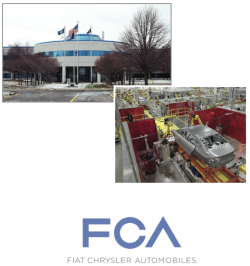 Fiat Chrysler Automobiles (FCA) is one of the largest manufacturers of automobiles in the world. Headquartered in Auburn Hills, Michigan, FCA US product brands include Chrysler, Dodge, Jeep, Ram, and FIAT, as well as the SRT performance vehicle designation. FCA has eight operating manufacturing facilities in the United States and Canada. These plants currently use outsourced vehicle releasing services, which are responsible for transporting and managing the finished vehicles from the assembly line and within the assembly plant vehicle shipping yard.
Fiat Chrysler Automobiles (FCA) is one of the largest manufacturers of automobiles in the world. Headquartered in Auburn Hills, Michigan, FCA US product brands include Chrysler, Dodge, Jeep, Ram, and FIAT, as well as the SRT performance vehicle designation. FCA has eight operating manufacturing facilities in the United States and Canada. These plants currently use outsourced vehicle releasing services, which are responsible for transporting and managing the finished vehicles from the assembly line and within the assembly plant vehicle shipping yard.
By analyzing the current cost structure for the vehicle releasing services and utilizing historical and industry trends, a recommendation will be made to install the most cost-effective operational structure. This can be specifically adjusted for each plant’s operations and services. Optimizing the vehicle releasing operations will reduce inventory costs and improve efficiency in the plant shipping yards.
Hess: Master Logistics Plan Optimization for Well Wastewater
Hess Corporation, a global exploration and production company, is extracting crude oil and natural gas, worldwide. Throughout the United States, areas of operation include North Dakota, West Texas, and Ohio. The Bakken Shale area of North Dakota contains 1,380 Hess operated wells, grouped into 584 different locations, or pads.
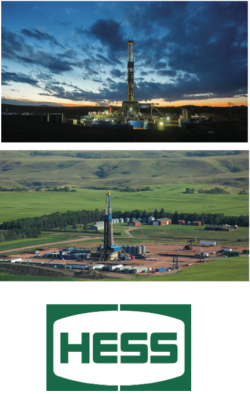 At these wells, water is used for lubricating the drill bit, and carrying the cuttings back to the surface for safe disposal. This water byproduct is then filtered away from the hydrocarbons, and brought to holding tanks at each pad. Third-party vendors transport the hazardous water to saltwater disposal wells throughout the Bakken region, and safely inject it back into the earth, to minimize environmental impact.
At these wells, water is used for lubricating the drill bit, and carrying the cuttings back to the surface for safe disposal. This water byproduct is then filtered away from the hydrocarbons, and brought to holding tanks at each pad. Third-party vendors transport the hazardous water to saltwater disposal wells throughout the Bakken region, and safely inject it back into the earth, to minimize environmental impact.
The objective of this project was to create a Master Logistics Plan, optimizing travel routes for Hess’s vendors, and minimizing total cost of ownership. Hess has a vested interest in vendor logistics, as pricing depends on barrels per load, which is influenced by transportation factors such as distance traveled. Several issues need to be researched throughout this process. Because wastewater production varies by pad, a schedule to increase efficiency and utilization will be created by analyzing past water production data. Further investigation into the numbers will allow us to score vendors and gain visibility into cost structures. Finally, Hess employs cutting edge LEAN methodologies to analyze performance of operations, with attention to safety, quality, delivery, and cost, all of which will play an integral part of the final Master Logistics Plan.
Ford Motor Company: Automotive Component Transportation, Import and Duty Costs in a Global Economy
Ford Motor Company is a world-class automobile manufacturing company, producing a wide range of vehicles globally. To optimize part costs, many vehicle components are imported from low-cost manufacturing regions such as India, China, Thailand, Mexico, North Africa, Eastern Europe (Poland, Czech Republic, Hungary, Romania) and Turkey. In many cases, reasonably accurate transportation, import and duty costs are not readily available when making sourcing decisions.
 Currently, many purchasing professionals have resorted to creating their own data repository to consider the costs and complete the required business case analysis needed for developing a sourcing recommendation. This method of analysis is no longer efficient or conducive to optimizing Ford Purchasing leverage.
Currently, many purchasing professionals have resorted to creating their own data repository to consider the costs and complete the required business case analysis needed for developing a sourcing recommendation. This method of analysis is no longer efficient or conducive to optimizing Ford Purchasing leverage.
This project seeks to analyze global transportation by examining import and duty costs from critically low-cost manufacturing regions. Research is to be conducted in order to provide a tool that generates an estimated cost per unit for shipping a vehicle part to a Midwest-based manufacturing facility. The tool should take into consideration a vehicle part’s country of origin, mode of transportation, part parameters, and any other pertinent information.
No matter what part is being shipped, whether it be a steering wheel or a front bumper, this tool will be capable of providing an output. With this ability, it will help ensure that Ford Purchasing is optimizing its sourcing leverage by awarding business in the region that offers the most optimal delivered cost to Ford’s manufacturing facilities.
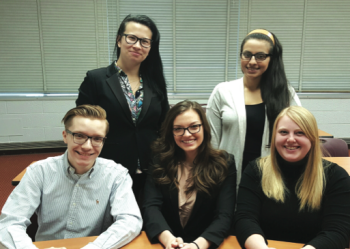
Team Members (L-R): Yulia Korneeva, Nedal Najeh Beny-Arid, Kyle Ashton Swinkin, Karlie Zuchowski, Morgan Middaugh
Asahi Kasei Plastics: Bulk Truck Utilization and Sequencing Optimization
 Asahi Kasei Plastics is a leading manufacturer of high performance plastic compounds that provides for multiple suppliers globally in industries such as automotive, furniture, and pools. The assignment provided by Asahi Kasei Plastics to its Michigan State University Applied Engineering Sciences 410 team is to assess and help improve the company’s bulk truck utilization and overall supply chain operations, productivity and effectiveness at their manufacturing and distribution site in Fowlerville, Michigan. The team will design a simulation of truck loading which will compare the different methods of storing and transporting the product and analyze the results to help the company determine any optimizations that can be made. One benefit the team’s finding will produce is improving idle times and on-time percentages. The analysis will account for variables such as integrated customer demand schedules, transit and loading times, as well as resultant customer satisfaction.
Asahi Kasei Plastics is a leading manufacturer of high performance plastic compounds that provides for multiple suppliers globally in industries such as automotive, furniture, and pools. The assignment provided by Asahi Kasei Plastics to its Michigan State University Applied Engineering Sciences 410 team is to assess and help improve the company’s bulk truck utilization and overall supply chain operations, productivity and effectiveness at their manufacturing and distribution site in Fowlerville, Michigan. The team will design a simulation of truck loading which will compare the different methods of storing and transporting the product and analyze the results to help the company determine any optimizations that can be made. One benefit the team’s finding will produce is improving idle times and on-time percentages. The analysis will account for variables such as integrated customer demand schedules, transit and loading times, as well as resultant customer satisfaction.
The challenges that the MSU team faces include determining the proper sequence of bulk truck loads and when to prepare the trailers to transport new types of plastics based on costly changeover procedures. Additions of the quantity of customers and bulk trucks to serve these customers are supplementary factors that will be incorporated into the data and models. The team will be using both Arena Simulation Software and Microsoft Excel to build and analyze the systems to determine the areas most in need of improvement. It is imperative to expand upon the original model design to include new silos and consider alternative bulk loading options.
Dow Chemical: Optimization of Chemical Shipping Rail Networks
Dow Chemical is a Fortune 500 company. As of March 2014, Dow Chemical’s market value stood at approximately 69 billion U.S dollars and they employed 53,000 people worldwide. Dow creates value through its diversified, market-driven portfolio and leveraging its cost advantages driven by scale and geographic presence. Our work with Dow means collaborating with innovators and solutions providers that are enhancing the quality of life for current and future generations.
 Rail transportation allows Dow to ship large quantities of product to create efficiency, economy, and sustainability within the Supply Chain. According to the U.S Department of Transportation, “The $60 billion industry consists of 140,000 rail miles.” The benefits of rail include reductions in road congestion, fuel consumption, greenhouse gasses, and logistics costs.
Rail transportation allows Dow to ship large quantities of product to create efficiency, economy, and sustainability within the Supply Chain. According to the U.S Department of Transportation, “The $60 billion industry consists of 140,000 rail miles.” The benefits of rail include reductions in road congestion, fuel consumption, greenhouse gasses, and logistics costs.
The primary objective was to identify and optimize the most effective routes to improve asset utilization.
The Dow plant position affords the opportunity to evaluate the transit performance of two Gulf Coast Railroads and identify alternate routing options vs. the railroad protocol for specific routes. The performance metrics to be considered are railroad transit time, mileage, and routing to major interchange points. This project exemplifies the challenges of “Big Data,” utilizing data mining techniques to analyze numerous patterns and relationships. In addition, a risk assessment was included to identify potential railroad system issues on specific rail routes that could delay or prevent effective transit. The end decision was to select between two Gulf Coast Railroads from specific plant origins resulting in an impact to Dow’s total rail cost.
ArcelorMittal: Micropelletize Iron Oxide Dust for Beneficial Reuse
Steel is used in all of the world’s most essential industries including construction, transportation, energy, and many others. ArcelorMittal is a steel company that provides steel for these industries. However, there are some downfalls to the company’s steelmaking process. During the process, there is some excess material created, a fine iron-oxide powder, that needs to be transported to a landfill and disposed of, if not reused. This comes at a cost to ArcelorMittal. Furthermore, since the powder is so fine, it creates a plume of dust when handled incorrectly. The plumes of dust create a safety risk for any person managing it due to concerns of inhaling the dust.
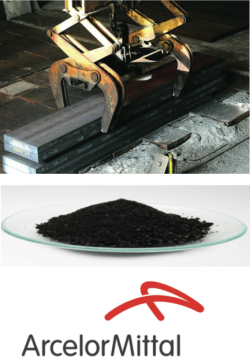 As of now, there is not an efficient way to reuse this material, however there is an opportunity to use the material that would not only reduce the need to dispose of the waste, but would also provide revenue to the company. This opportunity comes in the form of cement manufacturing.
As of now, there is not an efficient way to reuse this material, however there is an opportunity to use the material that would not only reduce the need to dispose of the waste, but would also provide revenue to the company. This opportunity comes in the form of cement manufacturing.
In the process of manufacturing cement, there is a need for a small amount of iron in each batch of cement processed. The primary goal for the team is to find an affordable process in which the fine powder can be formed into micropellets, or another shape. In this form, the powder would be easier to transport and more easily used by a cement company. Selling the micropellets would provide a revenue to ArcelorMittal, reduce safety risks of inhaling the dust, and reduce the environmental impact of disposing of the powder.
Ranir LLC: Packaging Optimization Project
 Ranir LLC is a private label producer of oral health care products based out of Grand Rapids. A current manual toothbrush packaging line is in need of improvement. This line includes the manual loading of toothbrushes into a pad printer which applies a customer’s brand and transports brushes to a machine where they are manually loaded into a blister pack. By assessing the current operation layout, packaging strategies, labor usage and overall line function, the goals of our group are to:
Ranir LLC is a private label producer of oral health care products based out of Grand Rapids. A current manual toothbrush packaging line is in need of improvement. This line includes the manual loading of toothbrushes into a pad printer which applies a customer’s brand and transports brushes to a machine where they are manually loaded into a blister pack. By assessing the current operation layout, packaging strategies, labor usage and overall line function, the goals of our group are to:
- Cut cost
- Maximize efficiency
- Reduce waste
- Lower complexity
This will be accomplished by working directly with Ranir’s engineering department, suppliers, operations, supply chain and the executive team. Upon successful completion, Ranir plans to assess deliverables for implementation in other facilities.
Android Industries: Assembly Line Variability Reduction
Android Industries is a tier one automotive supplier to General Motors. For more than 40 years, Android has assembled complex vehicle systems, producing more than 400 million in total. They are strategically located near the GM Delta Plant, which produces the Buick Enclave, GMC Acadia, and Chevrolet Traverse.
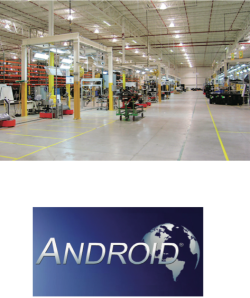 Android Industries is extremely customer focused. They strive for overwhelming customer satisfaction with both their internal customers and their external customers. They achieve this by working to produce a quality product free of defects, deliver it exactly on time in correct quantities, and do this as efficiently as possible. They pride themselves in their supply chain expertise, and have done substantial work in their Lansing plant to create an efficient, lean production system. They are focused on many aspects of continuous improvement, including ergonomics for their production workers, and reduction of waste in the plant.
Android Industries is extremely customer focused. They strive for overwhelming customer satisfaction with both their internal customers and their external customers. They achieve this by working to produce a quality product free of defects, deliver it exactly on time in correct quantities, and do this as efficiently as possible. They pride themselves in their supply chain expertise, and have done substantial work in their Lansing plant to create an efficient, lean production system. They are focused on many aspects of continuous improvement, including ergonomics for their production workers, and reduction of waste in the plant.
While they have developed an incredibly efficient process, Android Industries is now encountering some variance on their Instrument Panel assembly line at their Lansing facility. Currently, it cannot consistently achieve the Jobs-per-hour (JPH) rate based on their Planned Cycle Time (PCT) due to variability on the line.
The goal of this collaboration is to create a line that can consistently achieve the JPH rate, which would allow the plant to operate more efficiently and meet labor-cost budget. The first step toward a solution is to determine what is causing this variance on the line using tools like time trials and process flow mapping. The next step is to develop solutions for the areas that are found to be causing bottlenecks or other issues on the line, and finally to determine how to implement these solutions.
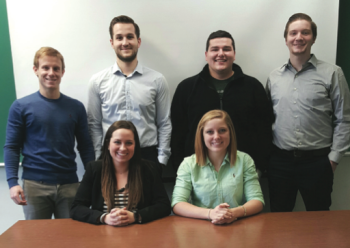
Team Members (L-R): Stefano Evangelista, Adam Raich, Kent Donajkowski, Jeff Bishop, Sarah Raich, Lisa Vogel
Microsoft: Efficient Use of Packaging, Pallets and Ramps
The Microsoft Cloud Infrastructure and Operations (MCIO) group is an exciting and fast evolving engineering group within Microsoft. MCIO is the operational and supply chain footprint that supports an $8B cloud business as of 2015, with plans to grow to a $20B business by 2018. MCIO’s mission is to optimize and deliver industry leading cloud infrastructure and foundational technologies for Microsoft’s online services. The organization is responsible for strategy and delivery of the foundational platform for all Microsoft Online Services including demand and capacity forecasting, supply chain, data centers, networking, bandwidth, operations, and incident management. MCIO supports over 200 online businesses including Bing, O365, OneDrive, Xbox and Windows Azure branded services.
 Microsoft’s data centers are located throughout the world. The shipping of pre-racked hardware used in these data centers often comes from several suppliers, each with their own packaging standards. The pre-racked hardware is a large rack that contains the computer servers, storage nodes, switches, etc. Our standard packaging solutions will help unify and simplify the delivery of the hardware into the data centers.
Microsoft’s data centers are located throughout the world. The shipping of pre-racked hardware used in these data centers often comes from several suppliers, each with their own packaging standards. The pre-racked hardware is a large rack that contains the computer servers, storage nodes, switches, etc. Our standard packaging solutions will help unify and simplify the delivery of the hardware into the data centers.
Accelerating the unloading process can save Microsoft money as well as cut down on delivery times. Speeding up the process on every level allows for quicker usage of data storage as well as increasing Microsoft Online Service’s speeds.
In addition to a faster connection process, safety will be greatly improved for those transporting the hardware. Due to the weight of the hardware, safety is a major concern. When there are many different ways to unload the racks, confusion over the correct process and mistakes can lead to severe, if not life- threatening, injuries. Having one understood process to remove the hardware from the packaging allows for less confusion and fewer mistakes.
Michigan State University Sustainability: Akers Hall Material Diversion Strategy
Recycling offers a diverse range of benefits, from being economically viable and improving the community image to its positive, and necessary, impact on our environment. While Michigan State University has an established recycling program that excels in this field, MSU Recycling has set an ambitious goal to increase recycling in the coming years. By the end of 2017, MSU strives to increase the recycling rate in buildings to at least 50% and divert 70% of its total waste stream.
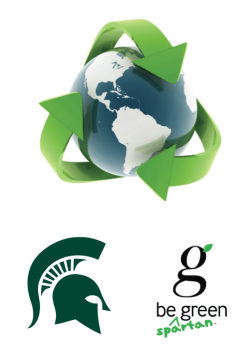 The residence halls make up a significant portion of the waste generated on campus. Akers Hall is the perfect starting point in the effort to reach the recycling goals, as it is a recently renovated residence hall housing mostly underclassmen. By developing improved practices for this living facility, the current and future residents will develop better recycling habits that they will carry with them to make a positive impact globally.
The residence halls make up a significant portion of the waste generated on campus. Akers Hall is the perfect starting point in the effort to reach the recycling goals, as it is a recently renovated residence hall housing mostly underclassmen. By developing improved practices for this living facility, the current and future residents will develop better recycling habits that they will carry with them to make a positive impact globally.
The aim of this project is to improve upon the existing recycling system in Akers Hall, and to both identify and divert recyclable materials from the landfill. This will be achieved by working with MSU Sustainability and MSU Recycling, together with residents and staff of Akers Hall, to analyze the current system in place and determine where the opportunities for improvements are. Once the opportunities are identified, improvements can be made. This will, in turn, create best practices that can be implemented in other residence halls across campus and throughout the nation.
Michigan State University Sustainability: Evaluation of Personal Hydration Sources On Campus
The topic of this project is Water Consumption at Michigan State University. The goal of the project is to develop a strategy to increase the consumption of tap water on campus. The analysis and recommendations from this project will feed into multiple other initiatives and will inform MSU’s water policies and practices.
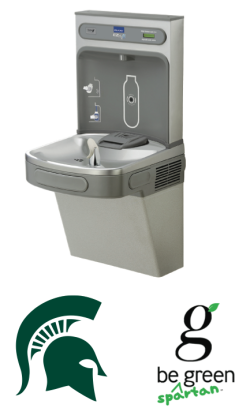 The team and sponsor designed a suggested plan of action for the project. First, the team is to assess the current system of filtered water bottle filling stations on campus. After the current assessment, the team is to identify design-centric solutions to provide water for personal hydration that meets quality standards of the end user. The team is to determine high use and high impact locations that would benefit from water filtration systems and analyze the Triple Bottom Line costs of installing such stations. After identifying a viable solution to increase the consumption of tap water, we will develop a marketing campaign to encourage the MSU community to drink filtered tap water and provide a guide to bottle filling stations.
The team and sponsor designed a suggested plan of action for the project. First, the team is to assess the current system of filtered water bottle filling stations on campus. After the current assessment, the team is to identify design-centric solutions to provide water for personal hydration that meets quality standards of the end user. The team is to determine high use and high impact locations that would benefit from water filtration systems and analyze the Triple Bottom Line costs of installing such stations. After identifying a viable solution to increase the consumption of tap water, we will develop a marketing campaign to encourage the MSU community to drink filtered tap water and provide a guide to bottle filling stations.
Assessing the costs of maintaining the bottled water supply on campus versus investing in filtered fill stations or other treatment options will be the major decision moving forward for Michigan State University Sustainability. Recommended solutions in regards to decreasing the consumption of bottled water will be provided by the team after the completion of their research.
Michigan State University Sustainability: Evaluation of Bottled Water Procurement at MSU
Michigan State University is a national public university founded in 1855. Since then it has grown to be one of the largest public universities with over 50,000 graduate and undergraduate students. With a growing student body, its water consumption is growing as well.
 MSU has its own utility company that utilizes wells and surface water to supply water for various sources such as power plants and residence halls. The water they produce also meets all federally regulated standards for water consumption. Although the water is drinkable, students are still choosing bottled water instead, leading to increased pressure on its recycling centers and landfill costs.
MSU has its own utility company that utilizes wells and surface water to supply water for various sources such as power plants and residence halls. The water they produce also meets all federally regulated standards for water consumption. Although the water is drinkable, students are still choosing bottled water instead, leading to increased pressure on its recycling centers and landfill costs.
The project analyzed the supply chain of the bottled water procurement at MSU to try to find deficiencies in the system. After that, different companies were assessed and then recommendations were made for the best vendors based on social, environmental, and economic factors.
Separately, an analysis was done on the added costs of bottled water on the landfill and recycling processes. This information was collected from surrounding stores to get a better estimate of how many bottles are potentially coming into MSU outside of the data available. With all of the information available at hand, recommendations were made to encourage people to use tap water instead of bottled water.
Michigan State University – IPF: Analysis Tool Development for Air Filtration System Optimization
This project improves the overall efficiency of MSU air-handling systems. As part of continuous optimization efforts, MSU Infrastructure Planning and Facilities (IPF) saw that the many air-handling systems across campus offered ample opportunity for improved energy efficiency. There are several aspects that were considered, which included analysis of the current system structure, data collection, improvement of the structure, cost calculation, and experimentation. By following these procedures, an improved air filtration system was designed and tested. Operating costs under different circumstances were calculated and compared in order to select the most economical option. Feedback was continuously collected and analyzed during the project.
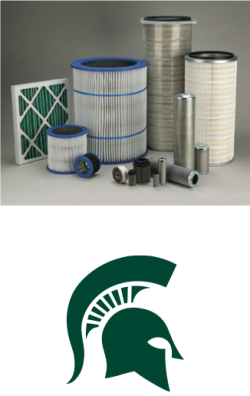 IPF currently maps, tracks and programs all air-handling systems on campus. Each system can accommodate various configurations of filters. Currently, low-cost pre- filters are used in line with higher cost bag filters. There are other methods of filtration on the market, including other higher efficiency membrane filters and electrostatic attraction filters that collect particles, odors and contaminants. It is necessary to keep in mind replacement, disposal and labor costs while investigating alternative methods of filtration. Data collection on the current system and comparison with third-party test results of alternative systems will be necessary to determine if a new system is necessary.
IPF currently maps, tracks and programs all air-handling systems on campus. Each system can accommodate various configurations of filters. Currently, low-cost pre- filters are used in line with higher cost bag filters. There are other methods of filtration on the market, including other higher efficiency membrane filters and electrostatic attraction filters that collect particles, odors and contaminants. It is necessary to keep in mind replacement, disposal and labor costs while investigating alternative methods of filtration. Data collection on the current system and comparison with third-party test results of alternative systems will be necessary to determine if a new system is necessary.
The primary objective for the team was to develop an analysis tool that could be used to simulate filter configuration effects on system static pressure, frequency of filter replacement, cost of materials, and filter replacement labor. Once the system has been tested and verified by MSU IPF, it will be implemented as an optimization tool for daily operations to reduce costs and environmental impact.
Intel: Alternate Design for Assembly Test Factory Network
Intel Corporation is an American multinational technology company headquartered in Santa Clara, California. Intel is one of the world’s largest and highest valued semiconductor chipmakers that supplies processors for companies such as Apple, Samsung, HP, and Dell.
 The objective of this project is to investigate and recommend a solution for an alternative raw material to convert into a component. The alternative raw material is required to meet all Intel technical, quality, environmental, social and governance (ESG) requirements. Examples of requirements include, but are not limited to, component drawing dimensions and tolerances, raw material mechanical and thermal properties, component finish and visual requirements, allowable defects per million (DPM), and raw material sourcing to meet all ESG standards.
The objective of this project is to investigate and recommend a solution for an alternative raw material to convert into a component. The alternative raw material is required to meet all Intel technical, quality, environmental, social and governance (ESG) requirements. Examples of requirements include, but are not limited to, component drawing dimensions and tolerances, raw material mechanical and thermal properties, component finish and visual requirements, allowable defects per million (DPM), and raw material sourcing to meet all ESG standards.
The second aspect of the project is to develop an optimized beginning-to- end worldwide supply line for Intel’s next generation CPU package technology. The optimized supply line will encompass a sourcing solution to procure the identified raw material, location(s) for the conversion process to the component specifications, inspection, packaging, and delivery of a total 1.5 million units (Mu) to Intel’s Assembly Test factory networks which are located primarily in Southeast Asia. Attributes of this supply line should include, but should not be limited to, optimized placement of inventory and carrying costs within the supply line, achieving availability requirements including factory service level agreement (SLA), exhibiting speed and agility from the procurement of the raw material to receipt of the component at factories, having a business continuity plan (BCP), and compliance to all ESG standards.
If commercialized, this solution will deliver 5% lower total supply line cost to include unit price (raw material, conversion, inspection, packaging and applicable margins), transportation, and inventory carrying.

Team Members (L-R): Michael Jones, Nicholas Schulte, Samantha Caves, Hali MacMillan, Michael Keller, Nicole Clark
Great Lakes Wine & Spirits: Increase Efficiency Through Automation
Great Lakes Wine and Spirits is Michigan’s largest wine and spirits distributor and has grown continuously since its conception in 1935. The company has grown to nearly 1,000 employees, operates in nine facilities around Michigan, and has an ever-expanding global supply chain network. The current environment for the facility is very labor-intensive. All bottles and cases are picked by hand each night, based on the demand that flows in from customers, to guarantee that they meet the 24-hour delivery window. On average 150,000 individual bottles and 50,000 cases are handpicked and loaded into more than 100 trucks each night.
In order to keep up with growing orders, as well as maintain its marketplace and competitive edge, the labor- intensive aspect of the current process needs to be optimized. To do so, Great Lakes Wine and Spirits is looking into increasing throughput and their space utilization by introducing automation to their current distribution centers. The goal of this project is to identify key processes that will benefit from automation while providing Great Lakes Wine and Spirits with a detailed plan of implementation for potential changes, supported by both technical and financial data.
